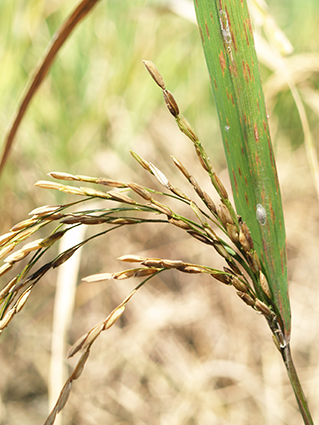A PhilRice crop protection expert reminds farmers that early detection is the best way to prevent spread of diseases in rice. 
Rice diseases are more prevalent during the rainy season as weather conditions are more conducive to disease development and severity.
Dr. Jennifer T. Niones from the Crop Protection Division (CPD) of PhilRice mentioned bacterial leaf blight (BLB), fungal diseases like rice blast, sheath blight, and rice tungro are among the major rice diseases farmers should watch out for.
“Choosing the right variety to plant that is high-yielding and adaptable to the local environment is crucial. Farmers must select varieties resistant to the diseases that previously attacked their farm,” Niones explained.
Presently, there are many modern varieties that are resistant to pests and diseases such as PSB Rc10 (for rice blast), Rc242 (for BLB), and Rc 120 (tungro).
Cultural management strategies must also be carefully observed. Niones said farmers should ensure that lands are well-prepared before they plant on it as pathogens and other bacterial cells can thrive on undecomposed rice stubbles and straw.
The modified dapog method is also recommended to fast-track seeding preparation and minimize transplanting shock. Farmers should also keep nursery beds and main fields from flooding and reduce plant injury during transplanting. Plant sanitation and regular weeding should also be practiced.
Niones also reminds farmers to avoid excessive use of nitrogen and synthetic chemicals in case of pest and disease infestation.
“It is a waste of resources. Farmers should focus on preventing the onset of the disease, not by spraying but by applying aforementioned cultural management practices. The use of chemicals to control bacterial leaf blight is not economical and effective,” Niones said.
In the pipeline, researchers of PhilRice’s CPD are screening breeding lines that are resistant to rice diseases. They are currently looking at traditional varieties as there are reports that they have high resistance against rice blast. They are also exploring the use of beneficial microorganisms as potential bio-control agents against BLB and blast.
“We hope to find novel genes (against rice blast) among those traditional varieties, so we can incorporate them in our modern varieties. The beauty of this is that we are working on our own materials,” Niones concluded.
To know more about pest and disease-resistant rice varieties, call or text the PhilRice Text Center at 0920 911 1398.




